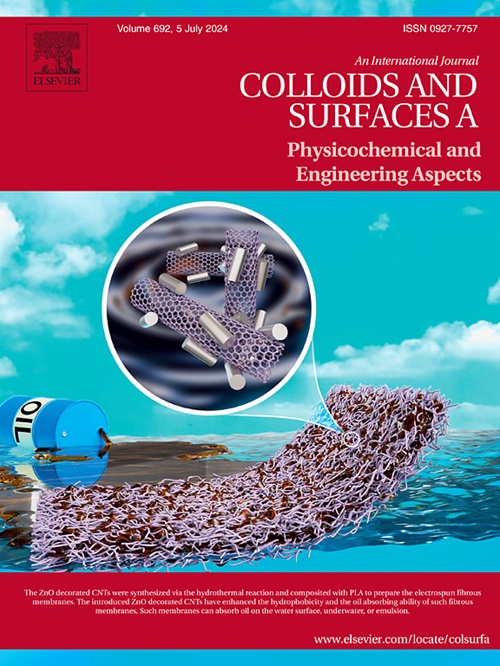高交联密度和纳米增强:双酚 A 环氧树脂粘合剂在腐蚀性环境中的性能
IF 4.9
2区 化学
Q2 CHEMISTRY, PHYSICAL
Colloids and Surfaces A: Physicochemical and Engineering Aspects
Pub Date : 2025-04-18
DOI:10.1016/j.colsurfa.2025.136839
引用次数: 0
摘要
传统的喷墨打印头通常使用粘合剂将电子元件与压电材料结合起来。当长时间浸泡在油墨中时,界面经常会发生脱粘。为了解决这一问题,我们以双酚A型环氧树脂和固化剂DDM为原料,同时加入纳米二氧化硅作为填料,开发了一种环氧树脂胶粘剂。通过非等温动力学对固化温度进行优化,确定其活化能为52.8 kJ mol−1,符合SB (m, n)模型。其形成的高交联网络能有效抵抗水和溶剂的侵入。结果表明,2.0 wt%的纳米sio₂是最优的,在180天内,其对乙二醇醚和水的吸收率分别降低了78 %和17.2% %。DMA和XPS测试表明,纳米sio₂增加了交联密度和机械稳定性,导致更高的存储模量和玻璃化转变温度。添加2.0 wt%,时效前后强度最高。老化前后的FTIR光谱表明,胶粘剂未发生水解,纳米sio 2的加入降低了溶剂和水的吸收率。我们的研究为开发适用于腐蚀性环境的高性能粘合剂(如喷墨打印头)提供了有价值的见解。本文章由计算机程序翻译,如有差异,请以英文原文为准。
High crosslink density and nano-ano enhancement: Performance of bisphenol A epoxy resin adhesives in corrosive environment
Traditional inkjet printheads typically utilize adhesives to combine electronic components with piezoelectric materials. When immersed in ink for extended periods, the interface often experiences debonding. To address this issue, we developed an epoxy resin adhesive by using bisphenol A epoxy resin and curing agent DDM, and simultaneously incorporating nano-SiO₂ as a filler. Through non-isothermal kinetics, we optimized the curing temperature and determined its activation energy to be 52.8 kJ mol−1, fitting the SB (m, n) model. The highly crosslinked network it forms can effectively resist the intrusion of water and solvents. Results indicate that 2.0 wt% nano-SiO₂ is optimal, reducing liquid absorption rates in ethylene glycol ether and water by 78 % and 17.2 %, respectively, over 180 days. DMA and XPS tests show that nano-SiO₂ increases the crosslinking density and mechanical stability, resulting in higher storage modulus and glass transition temperature. An addition of 2.0 wt% provided the highest strength before and after aging. FTIR spectra before and after aging indicate that the adhesive did not undergo hydrolysis, and the addition of nano-SiO₂ reduces the absorption rates of solvents and water. Our research offers valuable insights for developing high-performance adhesives suitable for corrosive environments, such as inkjet printheads.
求助全文
通过发布文献求助,成功后即可免费获取论文全文。
去求助
来源期刊
CiteScore
8.70
自引率
9.60%
发文量
2421
审稿时长
56 days
期刊介绍:
Colloids and Surfaces A: Physicochemical and Engineering Aspects is an international journal devoted to the science underlying applications of colloids and interfacial phenomena.
The journal aims at publishing high quality research papers featuring new materials or new insights into the role of colloid and interface science in (for example) food, energy, minerals processing, pharmaceuticals or the environment.

 求助内容:
求助内容: 应助结果提醒方式:
应助结果提醒方式:


